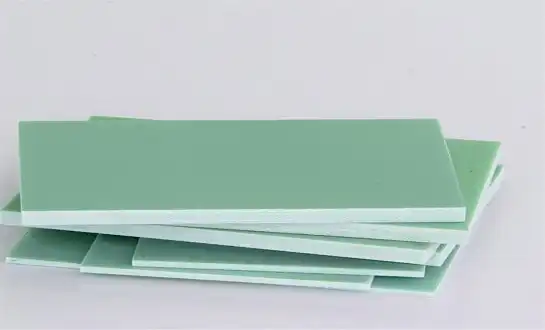It is important to carefully think about the electrical qualities, heat performance, and material strength of the 3240 epoxy sheet you choose for transformer insulation. This detailed guide looks at important factors that have a direct effect on the safety and stability of transformers, such as dielectric strength, temperature rates, thickness tolerances, and compliance standards. Understanding these specs is important for getting the best performance while also following industry rules and meeting long-term operating needs in power delivery uses.

Understanding 3240 Epoxy Sheet Material Properties
Understanding the unique properties of epoxy resin sheet materials is the first step to properly insulating a transformer. These high-performance insulated epoxy sheets are made of woven glass cloth that has been mixed with epoxy glue to give it great electrical and mechanical qualities.
Dielectric strength stands as the most crucial property for transformer applications. Good epoxy laminate sheets usually have dielectric strengths between 16 and 20 kV/mm, which means they reliably separate electrical currents between windings and grounded parts. The performance of this electrical insulation sheet stays the same even when the weather changes.
Thermal qualities have a big impact on the choices of materials. Heat-resistant epoxy sheets keep their shape at temperatures up to 155°C all the time, with short trips to 180°C. This temperature stability keeps the material from breaking down while the transformer is running, so the insulation works the same way for the whole life of the equipment.
Because of their mechanical strength, these materials can handle physical pressures that come up during use and assembly. The compressive strength of high-strength epoxy sheets is usually higher than 400 MPa, and they keep their shape when they are loaded. These mechanical features epoxy sheet specs are very important for keeping the exact distance between generator parts.
Critical Selection Criteria for Transformer Applications
To choose the right 3240 epoxy sheet, you have to compare a number of performance factors to the needs of the application. Knowing these factors helps engineering teams make decisions that improve the performance and stability of transformers.
A very important thing to think about when designing a transformer is the thickness limit. Precision-made epoxy fiberglass sheets keep width differences to less than 0.05 mm, which makes sure that electrical gaps and mechanical fit are always the same. This level of precision is especially important in small generator designs where limited room means that parts have to be placed exactly where they belong.
Both electrical efficiency and cutting traits are affected by the quality of the surface finish. Corona inception voltage is lower on surfaces that are smooth, and cutting and drilling with epoxy sheets is easier and more accurate. Manufacturers of industrial epoxy sheets usually list numbers for surface sharpness to make sure that the quality of each batch of production is the same.
Chemical protection traits protect the surroundings from damage. Good epoxy composite sheets don't let water in, so their electrical properties stay the same when it's wet outside. In tough working conditions, this resistance makes tools last longer and requires less upkeep.
Flame protection makes sure that safety standards are met around the world. Self-extinguishing mixtures stop fires from spreading and keep structures strong during heat events. When installing transformers in key infrastructure, these safety measures become very important.
Thickness and Dimensional Considerations
Choosing the right width has a direct effect on electrical gaps, industrial strength, and the ability to make the product. Knowing the choices you have and how they can be used helps you make the best design decisions for your transformer's needs.
Standard epoxy sheet thicknesses range from 0.5 mm to 50 mm, so they can be used in a wide range of situations. Thin sheets work best for small designs that need little room, while thicker materials are better for structural uses because they are stronger. Custom width choices meet specific needs that go beyond what is normally available.
Specifications for width and length affect how much material is used and how efficiently it is made. Standard sheet sizes keep costs down, while special sizes keep waste to a minimum in large-scale production. Coordinating the sizes of materials with the ways they are made makes both cost-effectiveness and output speed better.
Flatness standards make sure that the parts fit together correctly and that the electricity works. Quality control methods keep the smoothness within certain limits, which stops problems with assembly and builds up electrical stress. When making accurate transformers, these size standards become very important.
The quality of the edges affects both efficiency and safety. When edges are properly finished, they don't have any sharp points that could cause electrical stress or hurt workers while they're handling them. Professional resin sheet cutting makes sure that all parts have the same high-quality edges.
Electrical Performance Standards and Testing
Thorough electrical testing proves that the 3240 epoxy sheet is suitable for use in transformers. Knowing how to try things and what the standards for acceptance are is important for choosing materials that will work well and consistently in service.
Dielectric breakdown testing checks how much electricity a material can handle in normal circumstances. To make sure that the same results are obtained every time, testing methods spell out the electrode setups, voltage application rates, and weather conditions. These measures are very important for figuring out safe working voltages and lengths between components.
Insulation resistance qualities can be measured with volume resistivity tests. Volume resistance numbers for high-quality materials are higher than 1014 ohm-cm, which means that there aren't many stray currents during operation. This trait is still very important for keeping electricity working well and stopping power loses that aren't needed.
The dielectric constant tells us how a material will behave in alternating current situations. Stable insulating qualities across frequency ranges make sure that the transformer works as expected even when the load changes. Low dielectric loss features keep process temperatures from getting too high.
Arc resistance testing checks how a material reacts to electricity arcing. When faults happen, better materials keep the insulation's structure by resisting carbonization and tracks formation. This feature is very important for protecting the battery and making sure it works safely.
Temperature Ratings and Thermal Management
The thermal performance of a material has a direct effect on the material choice, the design of the application, and the expected service life. The right choice of temperature grade guarantees stable operation and extends the life and efficiency of equipment.
Continuous working temperature rates show the highest temperatures that an appliance can stay on for a long time. Class F materials can work constantly at 155°C, and Class H materials can work at 180°C. By knowing these values, you can choose the right material for a given temperature range and load level.
The short-term overload feature lets the temperature go above the constant rates for a short time. Good materials can handle short temperature drops without losing their properties permanently. This gives businesses more options when they are under a lot of stress or when their cooling system is temporarily down.
The way that dimensions stay stable when temperatures change affects how thermal expansion works. Low expansion factors keep electrical openings constant across a wide range of working temperatures and reduce stress buildup during temperature changes.
The way heat moves affects the design of thermal control. Materials with the right thermal conductivity make it easier to get rid of heat while keeping electricity from flowing through them. The general thermal performance of a transformer is best when its thermal and electrical features are balanced.
Quality Standards and Certification Requirements
Following foreign guidelines makes sure that the quality, safety, and performance of 3240 epoxy sheets are always the same. Knowing the standards for approval helps you choose the right materials while still meeting government rules and meeting customer goals.
UL approval makes electricity uses acceptable in the North American market. UL-listed materials go through strict tests for their electrical, thermal, and mechanical features. This makes sure that the quality and safety performance are always the same. This license is needed to get tools approved and to make sure that insurance rules are followed.
International guidelines for electrical shielding materials are set by the IEC. IEC 60893 is a standard that talks about thermosetting laminates and spells out how to test them and what their performance needs are. In order for a world market to accept something, it must be compliant with all relevant rules.
Following ROHS rules gets rid of dangerous materials used in making. Formulations without lead meet environmental rules and keep up their technical efficiency. This compliance is becoming more and more important for environmental duty and getting into global markets.
Getting ISO 9001 approval shows that your factory quality systems are reliable. Certified sellers keep records of their processes, methods for tracking goods, and programs for constant growth. This methodical technique guarantees the quality of the product and the speed with which it is delivered.
Machining and Fabrication Considerations
The ability to manufacture something affects both the quality of the parts and the cost of making them. Understanding how a material is machined lets you make things quickly while still meeting standards for accuracy in measurements and surface quality.
To get clean lines without delamination, cutting processes need the right tools and settings. When used at the right speeds, sharp carbide tools produce smooth cut surfaces while generating little heat. The right way to cut keeps the material from getting damaged and makes sure that the measurements are correct.
Careful parameter selection is needed during drilling operations to avoid drill damage and problems with the quality of the holes. When the speeds, feeds, and drill shapes are right, the holes are clean and don't have any burrs or delamination. Backing materials can often make holes in thin sheets look better.
Routing and shaping processes make it possible to make complicated forms and fit them perfectly. With computer-controlled cutting, the same thing can be done over and over again with little waste. Vibration-related quality problems can be avoided by using the right workholding and tools.
Surface cleaning processes improve how things look and how well they work. Depending on the purpose, sanding, polishing, or chemical processes can change the surface's features. Consistent finishing methods make sure that all of the parts have the same electrical and mechanical features.
Cost Optimization Strategies
Finding the best balance between performance needs and cost factors improves the project's economics while still meeting technical standards. Strategic decisions about what to buy and how to build things have a big effect on the general costs of a project without lowering the standard or performance.
Choosing the right material type has an impact on both price and function. When you know how the cost of a material affects its qualities, you can make smart decisions about how to balance performance gaps and budget limits. Overspecification makes prices go up for no reason, and underspecification can lead to problems with effectiveness.
Quantity concerns have a big effect on how prices are set. Buying in bulk lowers unit costs and makes sure that materials are always available for production plans. Long-term contracts with dependable suppliers keep costs stable and ensure a steady flow of goods.
Both cost and arrival times are affected by whether specs are standard or unique. Standard widths and grades save money, but unique requirements let you get the best performance for your individual needs. Both technical and economic results are best when these factors are balanced.
Beyond the price of raw materials, manufacturing efficiency affects the total cost of parts. By designing parts for efficient manufacturing processes, you can keep quality standards while cutting down on labor costs. When the planning and factory teams work together, performance and cost-effectiveness are both improved.
Conclusion
To choose the best 3240 epoxy sheet for transformer insulation, you need to carefully weigh the material's electrical, thermal, and mechanical qualities against the needs of the application. Knowing about dielectric strength, temperature values, physical tolerances, and compliance standards helps you choose materials that will work well with transformers and last a long time. Good providers give you the technical help, certifications, and production skills you need to turn material requirements into useful uses. Strategic relationships with experienced makers give you access to technical knowledge and make sure that your project will be successful in the long run by providing reliable supply chains and competitive price structures.
Partner with J&Q for Premium 3240 Epoxy Sheet Solutions
J&Q has been making and selling high-quality insulation sheets for more than twenty years and has also been dealing internationally for more than ten years. Because we have a lot of ties with selling companies in both the United States and other countries, we can offer complete solutions that meet the strictest standards for transformer shielding.
Our production skills cover all of the different uses for epoxy sheets, from precisely cut parts to custom-engineered solutions. During production, we keep a close eye on quality to make sure that every sheet meets the required electrical, heat, and material standards. Our in-house transportation business offers a smooth, one-stop service that gets rid of the need for complicated planning and long delivery times.
As a reliable company that makes 3240 epoxy sheets, we know how important it is to use them for transformer shielding. Our expert team works closely with customers to choose the best materials, which ensures the best performance while staying within budget. Throughout the lifetime of a project, we offer full material certificates, test results, and expert help.
Our world supplier network makes sure that materials are always available, and we keep our prices low. Our experienced team can provide solutions that go above and beyond your goals, whether you need standard grades for everyday uses or custom recipes for unique needs.
Are you ready to improve the shielding of your transformer? Our technical experts are ready to talk with you about your unique needs and suggest the best material options. Get in touch with us at info@jhd-material.com to start a conversation and find out how our skills can help your project succeed.
References
IEEE Standard C57.12.00-2015, "IEEE Standard for General Requirements for Liquid-Immersed Distribution, Power, and Regulating Transformers," Institute of Electrical and Electronics Engineers, 2015.
IEC 60893-3-2:2018, "Insulating materials - Industrial rigid laminated sheets based on thermosetting resins for electrical purposes - Part 3-2: Specifications for individual materials - Requirements for rigid laminated sheets based on epoxy resins," International Electrotechnical Commission, 2018.
ASTM D229-14, "Standard Test Methods for Rigid Sheet and Plate Materials Used for Electrical Insulation," American Society for Testing and Materials, 2014.
UL 1446, "Standard for Systems of Insulating Materials - General," Underwriters Laboratories Inc., 2017.
NEMA LI 1-1998, "Industrial Laminated Thermosetting Products," National Electrical Manufacturers Association, 1998.
IEC 60085:2007, "Electrical insulation - Thermal evaluation and designation," International Electrotechnical Commission, 2007.





